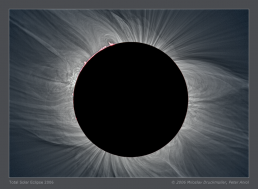

Lesson Plan:What and When is Solar Eclipse Maximum?
Created in collaboration with Tracey Kline, Lynn Public Schools, Lynn, MA
Grade Level: Middle School, NGSS: MS-ESS1-1 Earth’s Place in the Universe.
NGSS STANDARD
MS-ESS1-1: Develop and use a model of the Earth-Sun-Moon system to describe the cyclic patterns of lunar phases, eclipses of the sun and moon, and seasons. (Clarification Statement: Examples of models can be physical, graphical, or conceptual.)
LEARNING/ CONTENT/ LANGUAGE OBJECTIVE:
Students will be able to research the percentage of the eclipse in 3 locations and draw the eclipses from those locations.
LANGUAGE DEMAND:
Essential / Academic Vocabulary: annular eclipse, annularity, corona, maximum phase, total solar eclipse, totality
LESSON STRUCTURE
Lesson Beginning / Frame the Learning
(Clear entry routine, Do-Now, Activator, etc.; Frame the lesson by sharing and explaining lesson objective, agenda, and goals)
Differentiation
What supports and scaffolds am I providing based on the WIDA can-do descriptors?
![]()
![]()
![]()
![]()
![]()
![]()
![]()
![]()
![]()
![]()
- Images are in the Lesson Slides that are provided in Lesson Resources below.
![]()
![]()
![]()
![]()
![]()
![]()
![]()
![]()
![]()
![]()
![]()
![]()
![]()
![]()
- Provide word bank and sentence starters for students who need it.
In picture 1 I notice ….
In picture 2 I notice …
I wonder …
Resource: WIDA can-do descriptors
Lesson Middle
(I do- teacher directed; We do- practice with the teacher; You do- partner/small group application with teacher support)
* Revisit language objective and agenda; formative assessment- check for understanding (intervention and extension opportunities available)
Differentiation
What supports and scaffolds am I providing based on the WIDA can-do descriptors?
![]()
![]()
![]()
![]()
![]()
![]()
![]()
![]()
![]()
![]()
- Video provided in Lesson Resources below.
![]()
![]()
![]()
![]()
![]()
![]()
![]()
![]()
![]()
![]()
- Text provided in Lesson Resources below.
![]()
![]()
![]()
![]()
![]()
![]()
![]()
![]()
![]()
![]()
![]()
![]()
![]()
![]()
![]()
![]()
![]()
![]()
![]()
![]()
- Graphic Organizer provided in Lesson Resources below, one for 2023 annular and one for 2024 Total.
![]()
![]()
![]()
![]()
![]()
![]()
![]()
![]()
![]()
![]()
- Annular Solar Eclipse: https://www.timeanddate.com/eclipse/solar/2023-october-14
- Total Solar Eclipse: https://www.timeanddate.com/eclipse/map/2024-april-8
![]()
![]()
![]()
![]()
![]()
![]()
![]()
![]()
![]()
![]()
- Annular Solar Eclipse: https://www.timeanddate.com/eclipse/solar/2023-october-14
- Total Solar Eclipse: https://www.timeanddate.com/eclipse/map/2024-april-8
- Graphic Organizer is provided in Lesson Resources below.
![]()
![]()
![]()
![]()
- Pre-fill in some of the information in the Graphic Organizer for students ahead of time.
- Decrease the number of locations being researched with the student’s eclipse location as the highest priority.
![]()
![]()
![]()
![]()
Pairing strategy: Partner earlier proficient ELs with later proficient ELs or native English speakers.
Resource: WIDA can-do descriptors
Lesson End
(You do- independent application; Summarize learning; Clear exit routine)
* Formative assessment-exit ticket, check for understanding, etc.
![]()
![]()
![]()
![]()
![]()
![]()
![]()
![]()
![]()
![]()
FORMATIVE ASSESSMENT
How am I measuring success? (Connection to your Content/ Language objective)
Teacher can measure student success by collecting the students’ research information. The most important part to pay attention to is the information they found regarding the location they will be at for the eclipse.
LESSON RESOURCES
- What is Solar Eclipse Maximum? LESSON PLAN (Google Doc): When you open this link you will be prompted to make a copy of the Google document. This will allow you to download, print, and/or edit the lesson plan to best meet your needs.
- What is Solar Eclipse Maximum? LESSON SLIDES (Google Slides): When you open this link you will be prompted to make a copy of the Google slides. This will allow you to edit either of these slide options to best meet the needs of your classroom.
- Do Now HANDOUT: (Google Doc): When you open this link you will be prompted to make a copy of the Google document. This will allow you to download, print, and/edit the Google document to best meet the needs of your classroom.
- Text/Reading “What is Solar Eclipse Maximum?” HANDOUT (Google Doc): When you open this link you will be prompted to make a copy of the Google document. This will allow you to download, print, and/edit the Google document to best meet the needs of your classroom.
- Solar Eclipse Maximum Graphic Organizer 2023 ANNULAR HANDOUT (Google Doc): When you open this link you will be prompted to make a copy of the Google document. This will allow you to download, print, and/edit the Google document to best meet the needs of your classroom.
- Solar Eclipse Maximum Graphic Organizer 2024 TOTAL HANDOUT (Google Doc): When you open this link you will be prompted to make a copy of the Google document. This will allow you to download, print, and/edit the Google document to best meet the needs of your classroom.
- Video Clip | Eclipse Soundscapes (YouTube): – Video clip is also embedded in Lesson slides.
LESSON FEEDBACK
We want to hear from you! If you used this lesson plan or any of these resources, please submit lesson plan feedback via a short form!